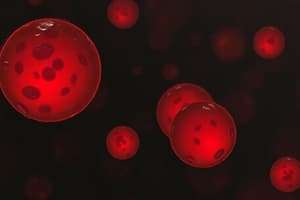Podcast
Questions and Answers
What is the average lifespan of circulating reticulocytes in nonanemic dogs and humans?
What is the average lifespan of circulating reticulocytes in nonanemic dogs and humans?
The average lifespan of circulating reticulocytes in nonanemic dogs and humans is 1-2 days.
How do reticulocytes appear on a Wright-stained blood film and why?
How do reticulocytes appear on a Wright-stained blood film and why?
Reticulocytes appear blue or basophilic on a Wright-stained blood film due to the presence of RNA.
What is the significance of NMB in the identification of reticulocytes?
What is the significance of NMB in the identification of reticulocytes?
NMB precipitates and stains the RNA and mitochondria in erythrocytes, revealing punctate or reticulated basophilic structures.
Why do cattle and horses typically not have circulating polychromatophilic erythrocytes?
Why do cattle and horses typically not have circulating polychromatophilic erythrocytes?
What variation occurs in the lifespan of reticulocytes in cats compared to dogs and humans?
What variation occurs in the lifespan of reticulocytes in cats compared to dogs and humans?
How do reticulocytes obtain their blue basophilic properties during staining?
How do reticulocytes obtain their blue basophilic properties during staining?
What does the presence of reticulocytes indicate about erythropoiesis in mammals?
What does the presence of reticulocytes indicate about erythropoiesis in mammals?
What characteristic distinguishes reticulocytes from mature erythrocytes?
What characteristic distinguishes reticulocytes from mature erythrocytes?
In which species can low concentrations of reticulocytes be detected, despite the absence of circulating polychromatophilic erythrocytes?
In which species can low concentrations of reticulocytes be detected, despite the absence of circulating polychromatophilic erythrocytes?
Why do reticulocytes have variable lifespans in cats compared to dogs and humans?
Why do reticulocytes have variable lifespans in cats compared to dogs and humans?
What staining technique is used to visualize reticulocytes and what does it reveal?
What staining technique is used to visualize reticulocytes and what does it reveal?
Study Notes
Reticulocytes Overview
- Immature erythrocytes that lack a nucleus, distinguished by cytoplasmic RNA.
- Staining with New Methylene Blue (NMB) allows visualization of RNA and mitochondria, creating punctate or reticulated structures.
Staining Characteristics
- NMB precipitates RNA and mitochondria during blood film preparation.
- On Wright-stained films, RNA imparts a blue, basophilic quality to polychromatophilic erythrocytes.
- Not all reticulocytes possess sufficient RNA for identification in Wright-stained blood films.
Lifespan and Maturation
- Nonanemic dogs and humans have reticulocyte lifespans of 1-2 days before maturing into erythrocytes.
- Lifespan of reticulocytes in cats is more variable compared to dogs and humans.
Species-Specific Observations
- In healthy cattle and horses, polychromatophilic erythrocytes are generally absent due to completion of maturation in the bone marrow.
- Some hematology analyzers may detect low levels of reticulocytes in horses despite this tendency.
Reticulocytes Overview
- Immature erythrocytes that lack a nucleus, distinguished by cytoplasmic RNA.
- Staining with New Methylene Blue (NMB) allows visualization of RNA and mitochondria, creating punctate or reticulated structures.
Staining Characteristics
- NMB precipitates RNA and mitochondria during blood film preparation.
- On Wright-stained films, RNA imparts a blue, basophilic quality to polychromatophilic erythrocytes.
- Not all reticulocytes possess sufficient RNA for identification in Wright-stained blood films.
Lifespan and Maturation
- Nonanemic dogs and humans have reticulocyte lifespans of 1-2 days before maturing into erythrocytes.
- Lifespan of reticulocytes in cats is more variable compared to dogs and humans.
Species-Specific Observations
- In healthy cattle and horses, polychromatophilic erythrocytes are generally absent due to completion of maturation in the bone marrow.
- Some hematology analyzers may detect low levels of reticulocytes in horses despite this tendency.
Studying That Suits You
Use AI to generate personalized quizzes and flashcards to suit your learning preferences.
Description
Explore the unique features of reticulocytes, including their non-nucleated structure and cytoplasmic RNA content. This quiz covers how NMB staining influences their appearance in blood films, as well as the significance of polychromatophilic erythrocytes. Test your understanding of these immature erythrocytes and their diagnostic implications.




